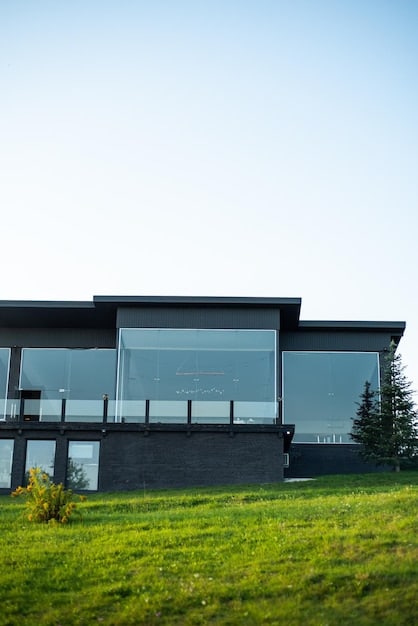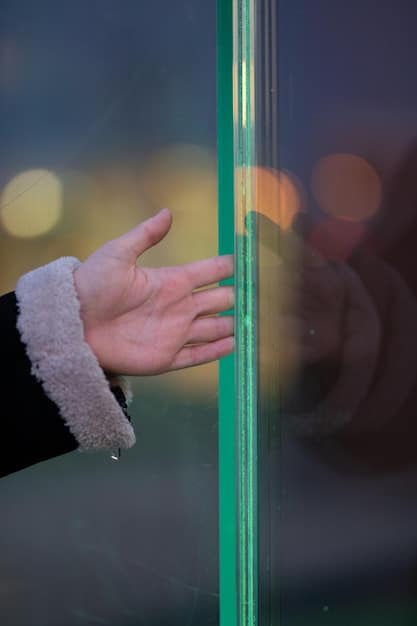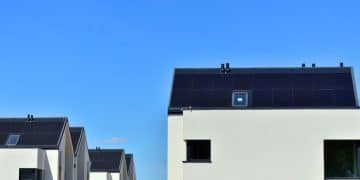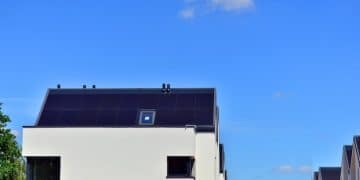How Energy-Efficient Windows Benefit US Homeowners: A Complete Guide

US homeowners can benefit from energy-efficient window technologies by reducing energy bills, increasing home comfort, enhancing property value, minimizing environmental impact, and potentially qualifying for tax credits and rebates.
Are you a US homeowner looking to save money and increase your home’s comfort? Exploring how can US homeowners benefit from the latest energy-efficient window technologies is a great place to start. Let’s examine the advantages of upgrading to energy-efficient windows and how they can transform your living space.
Understanding Energy-Efficient Windows
Energy-efficient windows are designed to minimize heat transfer, keeping your home cooler in the summer and warmer in the winter. This is achieved through various technologies and materials that reduce the amount of energy required to maintain a comfortable indoor temperature.
Key Components of Energy-Efficient Windows
Several components contribute to the overall energy efficiency of a window. These include the glazing, gas fills, frame materials, and spacers. Each plays a crucial role in reducing heat transfer and improving insulation.
Types of Glazing
Glazing refers to the glass panes in a window. Different types of glazing offer varying levels of energy efficiency. Common types include single-pane, double-pane, and triple-pane glass. Double-pane and triple-pane windows have insulating gas fills between the panes for added insulation. Low-E coatings are often applied to the glass to reflect heat and reduce UV rays.
- Single-Pane Glass: The least energy-efficient option, offering minimal insulation. Typically found in older homes.
- Double-Pane Glass: Offers improved insulation compared to single-pane windows. It features two panes of glass with a gap filled with air or gas.
- Triple-Pane Glass: Provides the highest level of insulation. It consists of three panes of glass with two gas-filled gaps for maximum energy savings.
Understanding these components helps homeowners make informed decisions when selecting energy-efficient windows. Choosing the right options can lead to significant savings and improved home comfort.

Reduced Energy Bills
One of the most significant benefits of energy-efficient windows is the reduction in energy bills. By minimizing heat transfer, these windows can significantly lower your heating and cooling costs.
How Energy-Efficient Windows Reduce Heating Costs
In the winter, energy-efficient windows prevent heat from escaping your home. This means your heating system doesn’t have to work as hard to maintain a comfortable temperature, resulting in lower heating bills.
How Energy-Efficient Windows Reduce Cooling Costs
During the summer, these windows block external heat from entering your home, reducing the need for air conditioning. This can lead to substantial savings on your cooling costs, particularly in hotter climates.
- Lower Electricity Bills: Less reliance on air conditioning translates to lower electricity consumption and reduced monthly bills.
- Reduced Burden on HVAC Systems: Energy-efficient windows help maintain a consistent indoor temperature, reducing the workload on your HVAC system.
- Long-Term Savings: While the initial cost may be higher, the long-term savings on energy bills can offset the investment.
In conclusion, energy-efficient windows offer substantial savings on energy bills by regulating indoor temperatures and reducing the workload on heating and cooling systems, making them a worthwhile investment for homeowners.
Enhanced Home Comfort
Beyond saving money, energy-efficient windows contribute to enhanced home comfort. These windows help maintain a consistent temperature throughout your home, eliminating drafts and cold spots.
Consistent Indoor Temperature
Energy-efficient windows help to maintain an even temperature throughout your home. This means that you’re less likely to experience cold spots near windows in the winter or overly warm areas in the summer.
Reduced Drafts and Cold Spots
Older, less efficient windows often have gaps and cracks that allow drafts to enter your home. Energy-efficient windows are designed to be airtight, reducing drafts and eliminating cold spots for a more comfortable living environment.
- Improved Air Quality: Tightly sealed windows prevent dust, pollen, and allergens from entering your home, improving indoor air quality.
- Noise Reduction: Energy-efficient windows, especially those with multiple panes of glass, can significantly reduce outside noise, creating a quieter, more peaceful home.
- Better Humidity Control: These windows help to maintain optimal humidity levels, preventing condensation and mold growth.
Therefore, energy-efficient windows not only cut energy costs but also improve comfort by maintaining temperature, reducing drafts, and enhancing overall indoor air quality, making houses more pleasant and healthy.
Increased Property Value
Investing in energy-efficient windows can increase your property value. Potential buyers are often willing to pay more for homes with energy-efficient features, making it a worthwhile investment.
Appeal to Potential Buyers
Energy efficiency is a major selling point for many homebuyers. Homes with energy-efficient windows are more attractive to buyers seeking lower utility bills and a comfortable living environment.
Long-Term Investment
Upgrading to energy-efficient windows is a long-term investment that can pay off when you decide to sell your home. It’s a feature that adds tangible value and can help your home stand out in the market.
- Modernization: Energy-efficient windows provide a modern, updated look, enhancing your home’s curb appeal.
- Sustainability: Eco-conscious buyers appreciate energy-efficient features, aligning with a growing demand for sustainable homes.
- Higher Appraisal Value: Energy-efficient upgrades can lead to a higher appraisal value, reflecting the added value of your home.
In summary, upgrading to energy-efficient windows is a solid investment that boosts curb appeal, appeals to eco-conscious buyers, and potentially raises the appraisal value of your home, ultimately increasing its overall market value.
Environmental Benefits
Choosing energy-efficient windows also provides significant environmental benefits. By reducing energy consumption, these windows help lower your carbon footprint and support sustainable living.

Reduced Carbon Footprint
Energy-efficient windows help reduce the amount of energy needed to heat and cool your home. This leads to lower greenhouse gas emissions and a smaller carbon footprint.
Support for Sustainable Living
By investing in energy-efficient windows, you’re supporting sustainable living practices. These windows contribute to a more environmentally friendly home and a healthier planet.
- Conservation of Resources: Reduced energy consumption helps conserve natural resources, such as fossil fuels and water.
- Lower Pollution Levels: Lower energy demand translates to reduced pollution from power plants, improving air and water quality.
- Positive Impact on Climate Change: Energy-efficient windows contribute to mitigating climate change by reducing greenhouse gas emissions.
To summarize, installing energy-efficient windows dramatically reduces carbon footprints, promotes the conservation of natural resources, and lowers pollution, bolstering environmentally conscious living and positively affecting climate change.
Tax Credits and Rebates
Many US homeowners can take advantage of tax credits and rebates when installing energy-efficient windows. These incentives can help offset the initial cost of upgrading your windows. It’s recommended you check with the IRS and your local energy provider.
Federal Tax Credits
The federal government often offers tax credits for energy-efficient home improvements. These credits can significantly reduce your tax liability and make energy-efficient windows more affordable.
State and Local Rebates
In addition to federal tax credits, many states and local utility companies offer rebates for installing energy-efficient windows. These rebates can help you save even more money on your upgrade.
- Check Eligibility: Research the specific requirements for tax credits and rebates to ensure your windows qualify.
- Keep Records: Maintain detailed records of your purchase and installation for tax purposes.
- Apply Promptly: Apply for rebates and tax credits as soon as possible, as funding may be limited.
In conclusion, homeowners should thoroughly research and promptly apply for federal tax credits and state/local rebates, maintaining detailed records to maximize savings and make energy-efficient window upgrades more financially appealing. It’s recommended you check with the IRS and your local energy provider.
| Key Point | Brief Description |
|---|---|
| 💰 Lower Energy Bills | Reduce heating and cooling costs with better insulation. |
| 🏡 Enhanced Comfort | Maintain consistent temperatures and reduce drafts. |
| 📈 Property Value | Increase home value with modern, energy-efficient upgrades. |
| 🌎 Eco-Friendly | Reduce carbon footprint and support sustainable living. |
Frequently Asked Questions (FAQ)
▼
Energy-efficient windows are designed to minimize heat transfer, conserving energy and reducing heating and cooling costs. They often feature multiple panes of glass and Low-E coatings.
▼
They reduce energy bills by providing better insulation, which keeps your home warmer in winter and cooler in summer. This reduces the workload on your HVAC system.
▼
While the initial cost can be higher, the long-term savings on energy bills and potential tax credits can offset the investment, making them cost-effective over time.
▼
Types include double-pane and triple-pane windows with gas fills, as well as windows with Low-E coatings and insulated frames. Each type offers different levels of efficiency.
▼
Signs include drafts, condensation between panes, difficulty opening or closing, and visibly damaged frames. These issues indicate that your windows are no longer energy-efficient.
Conclusion
In conclusion, energy-efficient windows offer numerous benefits for US homeowners, including reduced energy bills, enhanced home comfort, increased property value, and significant environmental advantages. By understanding the technologies and incentives available, homeowners can make informed decisions to improve their living spaces and contribute to a more sustainable future.





